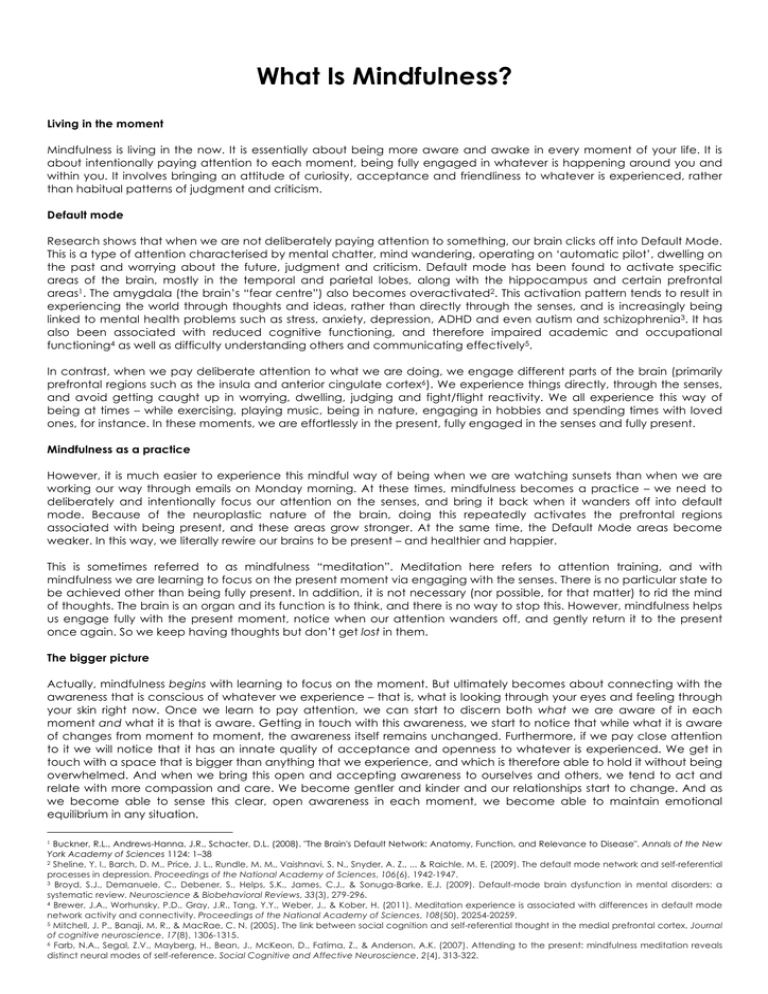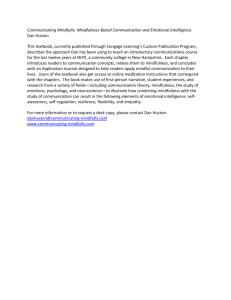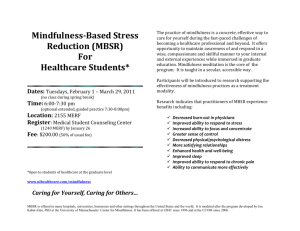What Is Mindfulness?
advertisement

What Is Mindfulness? Living in the moment Mindfulness is living in the now. It is essentially about being more aware and awake in every moment of your life. It is about intentionally paying attention to each moment, being fully engaged in whatever is happening around you and within you. It involves bringing an attitude of curiosity, acceptance and friendliness to whatever is experienced, rather than habitual patterns of judgment and criticism. Default mode Research shows that when we are not deliberately paying attention to something, our brain clicks off into Default Mode. This is a type of attention characterised by mental chatter, mind wandering, operating on ‘automatic pilot’, dwelling on the past and worrying about the future, judgment and criticism. Default mode has been found to activate specific areas of the brain, mostly in the temporal and parietal lobes, along with the hippocampus and certain prefrontal areas1. The amygdala (the brain’s “fear centre”) also becomes overactivated2. This activation pattern tends to result in experiencing the world through thoughts and ideas, rather than directly through the senses, and is increasingly being linked to mental health problems such as stress, anxiety, depression, ADHD and even autism and schizophrenia3. It has also been associated with reduced cognitive functioning, and therefore impaired academic and occupational functioning4 as well as difficulty understanding others and communicating effectively5. In contrast, when we pay deliberate attention to what we are doing, we engage different parts of the brain (primarily prefrontal regions such as the insula and anterior cingulate cortex6). We experience things directly, through the senses, and avoid getting caught up in worrying, dwelling, judging and fight/flight reactivity. We all experience this way of being at times – while exercising, playing music, being in nature, engaging in hobbies and spending times with loved ones, for instance. In these moments, we are effortlessly in the present, fully engaged in the senses and fully present. Mindfulness as a practice However, it is much easier to experience this mindful way of being when we are watching sunsets than when we are working our way through emails on Monday morning. At these times, mindfulness becomes a practice – we need to deliberately and intentionally focus our attention on the senses, and bring it back when it wanders off into default mode. Because of the neuroplastic nature of the brain, doing this repeatedly activates the prefrontal regions associated with being present, and these areas grow stronger. At the same time, the Default Mode areas become weaker. In this way, we literally rewire our brains to be present – and healthier and happier. This is sometimes referred to as mindfulness “meditation”. Meditation here refers to attention training, and with mindfulness we are learning to focus on the present moment via engaging with the senses. There is no particular state to be achieved other than being fully present. In addition, it is not necessary (nor possible, for that matter) to rid the mind of thoughts. The brain is an organ and its function is to think, and there is no way to stop this. However, mindfulness helps us engage fully with the present moment, notice when our attention wanders off, and gently return it to the present once again. So we keep having thoughts but don’t get lost in them. The bigger picture Actually, mindfulness begins with learning to focus on the moment. But ultimately becomes about connecting with the awareness that is conscious of whatever we experience – that is, what is looking through your eyes and feeling through your skin right now. Once we learn to pay attention, we can start to discern both what we are aware of in each moment and what it is that is aware. Getting in touch with this awareness, we start to notice that while what it is aware of changes from moment to moment, the awareness itself remains unchanged. Furthermore, if we pay close attention to it we will notice that it has an innate quality of acceptance and openness to whatever is experienced. We get in touch with a space that is bigger than anything that we experience, and which is therefore able to hold it without being overwhelmed. And when we bring this open and accepting awareness to ourselves and others, we tend to act and relate with more compassion and care. We become gentler and kinder and our relationships start to change. And as we become able to sense this clear, open awareness in each moment, we become able to maintain emotional equilibrium in any situation. 1 Buckner, R.L., Andrews-Hanna, J.R., Schacter, D.L. (2008). "The Brain's Default Network: Anatomy, Function, and Relevance to Disease". Annals of the New York Academy of Sciences 1124: 1–38 2 Sheline, Y. I., Barch, D. M., Price, J. L., Rundle, M. M., Vaishnavi, S. N., Snyder, A. Z., ... & Raichle, M. E. (2009). The default mode network and self-referential processes in depression. Proceedings of the National Academy of Sciences, 106(6), 1942-1947. 3 Broyd, S.J., Demanuele, C., Debener, S., Helps, S.K., James, C.J., & Sonuga-Barke, E.J. (2009). Default-mode brain dysfunction in mental disorders: a systematic review. Neuroscience & Biobehavioral Reviews, 33(3), 279-296. 4 Brewer, J.A., Worhunsky, P.D., Gray, J.R., Tang, Y.Y., Weber, J., & Kober, H. (2011). Meditation experience is associated with differences in default mode network activity and connectivity. Proceedings of the National Academy of Sciences, 108(50), 20254-20259. 5 Mitchell, J. P., Banaji, M. R., & MacRae, C. N. (2005). The link between social cognition and self-referential thought in the medial prefrontal cortex. Journal of cognitive neuroscience, 17(8), 1306-1315. 6 Farb, N.A., Segal, Z.V., Mayberg, H., Bean, J., McKeon, D., Fatima, Z., & Anderson, A.K. (2007). Attending to the present: mindfulness meditation reveals distinct neural modes of self-reference. Social Cognitive and Affective Neuroscience, 2(4), 313-322. The Science Of Mindfulness There is growing evidence that even relatively short mindfulness programs such as this one can result in improvements to: Cognitive and academic performance − − − − − Improves ability to maintain preparedness and orient attention7 8 Improves short term memory and processing speed9 Improves ability to process information quickly and accurately10 Increased thickness of brain regions involved in self-awareness and sensory processing11 Long-term mindfulness meditation practice has even been shown to result in the ability to bring 100% concentration to a chosen object or mental state for an indefinite period (the experiment, using an fMRI brain imaging device, was stopped after 30 minutes, but the monk being studied said he could have gone on concentrating as long as they needed him to!) Health and wellbeing − − − − Decreases stress, anxiety, and depression12 Supports better regulation of emotional reactions and increases positive psychological states13 Decreases burnout14 Increased immunity to the influenza virus15 Improved relationships − − − Increases creativity16 Improves skills needed for interpersonal relationships17 Improves empathy and compassion18 Brain imagining research also shows that regular mindfulness practice for 15 minutes a day over a 6-week period produces growth in brain areas associated with learning and memory processes, emotion regulation, self-referential processing, and perspective-taking19. 7 Chan, D., & Woollacott, M. (2007). Effects of level of meditation experience on attentional focus: is the efficiency of executive or orientation networks improved?. The Journal of Alternative and Complementary Medicine, 13(6), 651-658. 8 Shapiro, S.L., Oman, D., Thoresen, C.E., Plante, T.G., & Flinders, T. (2008). Cultivating mindfulness: effects on well‐being. Journal of clinical psychology, 64(7), 840-862. 9 Chambers, R.H., Lo, B.C.Y., & Allen, N.B. (2008). The impact of intensive mindfulness training on attentional control, cognitive style, and affect. Cognitive Therapy and Research, 32(3), 303-322. 10 Slagter, H.A., Lutz, A., & Greischar, L.L. (2007). Mental training affects distribution of limited brain resources. PLoS Biology, 5(6). 11 Lazar, S.W. et al. (2005). Meditation experience is associated with increased cortical thickness. Neuroreport, 16(17), 1893. 12 Hofmann, S.G., Sawyer, A.T., Witt, A.A., & Oh, D. (2010). The effect of mindfulness-based therapy on anxiety and depression: A meta-analytic review. Journal of consulting and clinical psychology, 78(2), 169. 13 Jain, S., Shapiro, S.L., Swanick, S., Roesch, S.C., Mills, P.J., & Schwartz, G.E. (2007). A randomized controlled trial of mindfulness meditation versus relaxation training: Effects on distress, positive states of mind, rumination, and distraction. Annals of Behavioral Medicine, 33(1), 11-21. 14 Goodman, M.J., & Schorling, J.B. (2012). A mindfulness course decreases burnout and improves well-being among healthcare providers. The International Journal of Psychiatry in Medicine, 43(2), 119-128. 15 Davidson, R.J. et al. (2003). Alterations in brain and immune function produced by mindfulness meditation. Psychosomatic medicine, 65(4), 564-570. 16 Horan, R. (2009). The neuropsychological connection between creativity and meditation. Creativity Research Journal, 21(2-3), 199-222. 17 Gambrel, L.E., & Keeling, M.L. (2010). Relational aspects of mindfulness: Implications for the practice of marriage and family therapy. Contemporary Family Therapy, 32(4), 412-426. 18 Neff, K.D., Kirkpatrick, K.L., & Rude, S.S. (2007). Self-compassion and adaptive psychological functioning. Journal of research in personality, 41(1), 139-154. 19 Hölzel, B. K., Carmody, J., Vangel, M., Congleton, C., Yerramsetti, S. M., Gard, T., & Lazar, S. W. (2011). Mindfulness practice leads to increases in regional brain gray matter density. Psychiatry Research: Neuroimaging, 191(1), 36-43. Mindfulness And The Brain The brain is comprised of 100 billion neurons (nerve cells) arranged in a circuit with around 100 trillion connections. When we experience something for the first time, the dendrites of neurons form connections with the dendrites of other neurons, and a neural pathway is formed. For instance, when people start playing piano, new connections are formed in their brain. And if they experience playing piano a number of times – that is, practise playing – the connections will get stronger and stronger. As well as new connections being formed, the brain starts growing entirely new neurons to accommodate the new learning. This is known as ‘neuroplasticity’ (a combination of ‘neuron’ and plasticity, which means the ability to be molded – think of plasticine). As we continue practicing, the neurons must move farther apart to accommodate these new connections, and the brain literally grows. In this way it is just like a muscle, and practice of any sort is like a workout. What is even more interesting is that mental practice creates these changes. A famous experiment once got a group of people to practice piano for an hour a day for 5 days and then put these people in a Magnetic Resonance Imaging (MRI) ‘brain scanner’ at the end. As might be expected, areas of the brain associated with fine motor movement and distinguishing different sounds were thicker, with more neurons and connections, compared to before the period of practice. Perhaps even more interesting, there was a second group of people who spent an hour a day for the five days imagining themselves playing piano, without ever actually touching a keyboard. And at the end of the five days, when tis second group was put in the MRI, what do you think the researchers found? The same areas of the brain that had grown in the first group had increased in the second group! In fact, there was no difference between the groups20. This demonstrated that mental rehearsal, as well as actual physical practice, creates neuroplastic changes in the brain. This is significant because we ‘practice’ Default Mode most of the time. As outlined above, when we are not paying attention to something, we click off into mind-wandering and automatic pilot. This then gets hardwired into the brain, and we become even more likely to be in this mode. However, when we practise mindfulness (i.e. pay attention to what we are doing and experiencing), different parts of the brain are activated. These areas then become stronger and thicker, and we start experiencing these patterns of activation spontaneously. This is why people who practise mindfulness meditation find that they naturally start catching themselves in Default Mode throughout the day. And any time we catch ourselves in Default Mode we are no longer in Default Mode in that moment. At the same time, because of the use-it-or-lose-it nature of neuroplasticity, the parts of the brain associated with Default Mode become weaker and eventually start to disappear. In this way, practicing mindfulness literally changes our brain. 20 Pascual-Leone, A., Dang, N., Cohen, L. G., Brasil-Neto, J. P., Cammarota, A., & Hallett, M. (1995). Modulation of muscle responses evoked by transcranial magnetic stimulation during the acquisition of new fine motor skills. Journal of Neurophysiology, 74, 1037-1037.



